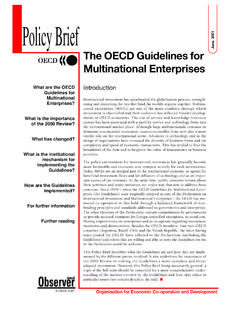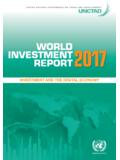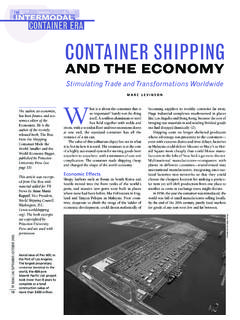Transcription of NBER WORKING PAPER SERIES THE EFFECTS OF …
1 NBER WORKING PAPER SERIES . THE EFFECTS OF multinational PRODUCTION. ON WAGES AND WORKING conditions . IN developing countries . drusilla K. Brown Alan V. Deardorff Robert M. Stern WORKING PAPER 9669. NATIONAL BUREAU OF ECONOMIC RESEARCH. 1050 Massachusetts Avenue Cambridge, MA 02138. April 2003. Presented at NBER/CEPR/SNS Conference, International Seminar on International Trade (ISIT), Challenges to Globalization, H berge G rd, Stockholm, May 24-25, 2002. The views expressed herein are those of the authors and not necessarily those of the National Bureau of Economic Research. 2003 by drusilla K. Brown, Alan V. Deardorff, and Robert M. Stern. All rights reserved. Short sections of text not to exceed two paragraphs, may be quoted without explicit permission provided that full credit including notice, is given to the source. The EFFECTS of multinational Production on Wages and WORKING conditions in developing countries drusilla K. Brown, Alan V. Deadorff, and Robert M. Stern NBER WORKING PAPER No.
2 9669. April 2003. JEL No. F2. ABSTRACT. This PAPER assesses the evidence regarding the EFFECTS of multinational production on wages and WORKING conditions in developing countries . It is motivated by recent controversies concerning whether multinational firms in developing countries exploit workers by paying low wages and subjecting them to substandard conditions . We first address efforts of activist groups, universities, and colleges in the "Anti-Sweatshop" Campaign in the United States, the social accountability of multinational firms, and the role of such international institutions as the International Labor Organization and World Trade Organization in dealing with labor standards and trade. We then consider conceptually how foreign direct investment might affect host-country wages. Available theories yield ambiguous predictions, leaving the EFFECTS to be examined empirically. We therefore, finally, review empirical evidence on multinational firm wages in developing countries , and the relationship between foreign direct investment and labor rights.
3 This evidence indicates that multinational firms routinely provide higher wages and better WORKING conditions than their local counterparts, and they are typically not attracted preferentially to countries with weak labor standards. drusilla K. Brown Alan V. Deardorff Robert M. Stern Department of Economics Department of Economics Department of Economics Tufts University University of Michigan University of Michigan Medford, MA 02155 Ann Arbor, MI 48109- Ann Arbor, MI 48109- 1220 1220. The EFFECTS of multinational Production on Wages and *. WORKING conditions in developing countries drusilla K. Brown, Tufts University Alan V. Deardorff, University of Michigan Robert M. Stern, University of Michigan I. Introduction This PAPER is designed to assess the empirical evidence on the EFFECTS of multinational production on wages and WORKING conditions in developing countries . It is motivated by the controversies that have emerged especially in the past decade or so concerning whether or not multinational firms in developing countries are exploiting their workers in sweatshop conditions by paying low wages and subjecting them to coercive, abusive, and unhealthy and unsafe conditions in the workplace.
4 Thus, in Section II, we address these controversies in the context of the efforts and programs of social activist groups and univer- sities and colleges involved in the Anti-Sweatshop Campaign in the United States and the related issues of the social accountability of multinational firms and the role of such international institutions as the In- ternational Labor Organization (ILO) and World Trade Organization (WTO) in dealing with labor stan- dards and trade. We then turn more broadly in Section III to a conceptual treatment of the EFFECTS of for- eign direct investment (FDI) on wages in host countries and the EFFECTS of outsourcing and subcontracting by multinational firms. Thereafter, the empirical evidence on multinational -firm wages in developing countries is reviewed in Section IV, together with evidence on the relationship between FDI and labor rights. Conclusions are presented in Section V. II. Political Economy Issues As mentioned, our PAPER has been motivated by the controversies as to whether multinational firms are exploiting and mistreating their workers by employing them under sweatshop conditions .
5 What this *. We wish to thank Robert Baldwin, Elliot Berg, Rob Howse, Rachel McCulloch, Ian Robinson, Andr Sapir, par- ticipants in the NBER pre-conference meeting, and participants in the NBER/CEPR/SNS Stockholm conference, as well as seminar participants at the University of Michigan and the University of Leuven, for their helpful comments on earlier versions of our PAPER . We also thank Gladys Mitchell for research assistance and Judith Jackson for edito- rial and typing assistance. 3. means is exploiting the workers by paying low wages and subjecting them to violations of certain univer- sal social norms or standards governing their employment. In this connection, Moran (2002) has stressed the importance of distinguishing low-wage, relatively unskilled labor-intensive industries such as apparel and footwear from industries that employ more highly skilled workers and produce relatively more skill- intensive products such as electronics and automotive products. Many social activists and activist organi- zations that are critical of multinational wages and WORKING conditions in developing countries do not make this distinction.
6 Rather, much of the criticism by social activists in the United States especially has been directed at multinational operations in the apparel and footwear industries that are allegedly produc- 1. ing under sweatshop conditions . We turn next accordingly to consider the salient anti-sweatshop is- sues. The Anti-Sweatshop Campaign in the United States Elliot and Freeman (2001, pp. 15-16) note that: Sweatshops have characterized apparel production since industrial revo- lution days, and so too have campaigns to improve labor conditions in the industry. Many of the issues are the same, but a major difference between anti-sweatshop campaigns at the turn of the 21st century and those at the turn of the 20th century is that sweatshops then were largely local whereas today they are found mostly in poor developing countries . This means that activists cannot lobby the government to improve labor standards. Instead they must target corpora- tions who operate or source in developing countries or pressure the world 2.
7 Trading community to demand changes in less developed countries .. 1. Graham (2000, pp. 101-102) has noted that products originating in the footwear, apparel, toy-making, and sporting goods industries combined accounted for less than 10 percent of world merchandise exports in 1997. He then states: If indeed sweatshop conditions are concentrated in these industries, they do not represent the greater part of global- ized economic activity. It would be more meaningful, however, to consider how important the exports of these goods are for developing countries , rather than for the world as a whole. Graham's source, WTO (1998), does not report trade by level of development. But its geographic data are suggestive: WTO(2000) reports textile exports as a percent of manufactured exports to be only for Latin America, for Africa, and for Asia excluding Australia, Japan, and New Zealand. 2. Robert Baldwin has pointed out to us that the unfavorable perception of FDI, and industrialization in general, may be related historically to the change from a household to a factory system of production.
8 Thus, one does not usually think of a family engaged in household production as WORKING under sweatshop conditions . It is mainly when work- ers are assembled to produce in factories that it is believed that they may be subjected to sweatshop conditions , even though their wages may be higher and children may have more access to education and better medical care. 4. Elliot and Freeman (2001, pp. 48-49) provide a timeline of anti-sweatshop activities from 3. 1990 to spring 2000, and a list of transnational labor rights activist organizations (Appendix Exhibit A). As they note (pp. 16-17), during this period, multinationals such as Levi Strauss, Gap, Phillips- VanHeusen, and others were singled out for condoning undesirable labor practices. And Wal-Mart, a ma- jor retailer, was cited as selling clothing made by child labor in Bangladesh and Honduras. Many of the firms involved in producing or sourcing abroad have responded to the criticisms by adopting codes of 4. conduct that are designed presumably to guide their operations.
9 In 1996, the Clinton Administration es- tablished the Apparel Industry Partnership (AIP) to address sweatshop issues globally by bringing to- gether apparel firms, unions, and NGOs by means of a code of conduct and a monitoring system that were introduced in April 1997 and that would be applicable to the firms involved. Subsequently, in November 1998, the AIP established the Fair Labor Association (FLA) to implement and monitor the code. Some groups, in particular the Union of Needletrades, Industrial and Textile Employees (UNITE), were critical of the AIP/FLA program, complaining as Elliott and Freeman note (p. 17) that the code failed to re- quire payment of a living wage; had weak language with respect to union rights in nondemocratic coun- tries; and had a weak monitoring and verification system. Nonetheless, by fall 2000, 140 colleges and universities had become affiliated with the FLA, and, as of the end of 2001, the number had grown to 5. 192. It was during this period that student activism on sweatshops took hold at a number of American campuses.
10 A group called Students Against Sweatshops was established at Duke University in August 1997. With assistance from UNITE, the United Students Against Sweatshops (USAS) was established on a national basis in summer 1998. In expressing their dissatisfaction with the FLA, the student members of the USAS orchestrated sit-ins during 1999 at a number of prominent universities and colleges. On Oc- 3. See also Varley (1998, pp. 12-13). 4. We have more to say on this below. 5. The list of colleges and universities affiliated with the FLA can be found at [ ]. 5. tober 19, 1999, the USAS announced the creation of the Worker Rights Consortium (WRC) and urged institutions to withdraw from the FLA and join the WRC, which purportedly had a stronger code of con- duct, a focus on worker complaints and education on worker rights, and a requirement for disclosure of the name and location of factories producing licensed apparel. As of June 2000, 50 institutions had be- come affiliated with the WRC.
















